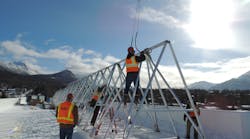Latest from Plumbing Contractor
Sponsored
Alaska contractor standardizes residential, commercial projects
ANCHORAGE, ALASKA — Klebs Mechanical is one of the largest mechanical companies in town here. Started in 1986, the residential and commercial company has grown with the city, and knows how best to handle its eccentricities.
By land mass, Anchorage, Alaska, is roughly the size of the state of Delaware. And its population — around 300,000 — accounts for more than 40% of Alaska’s inhabitants. Like most western cities, Anchorage simply sprawled through its development, and continues to, due to a lack of anything to contain it.
Today, Alaska is seeing growth and construction unlike anything since the gold rush of the 1890s and the oil boom of the 1970s. The surge is driven simultaneously by several factors. While the state adds infrastructure and manpower associated with rising natural gas production, military and defense spending continues. Lately, private investment has also been high, with a lot of large retail corporations headed to the state. Possibly the biggest growth, though, has been in the health care industries. It all adds up to population growth, especially in Anchorage.
While getting to and from jobsites, Anchorage not only challenges drivers with a growing urban landscape, but seemingly endless miles of open highway out of town. Not that the scenery along the Seward Highway is hard to look at, not by a long shot, but if trade professionals aren’t dealing with traffic in town, they’re pounding pavement across vast expanses of Coastal Alaska.
Saving miles, hours
“We’ll do all the work we can in the shop before heading to the jobsite,” said VP Matt Klebs, who takes the company into its second generation. The firm’s large sheet metal and prefab shop saves many miles and hours that would be spent on the road in order to complete the same tasks on-site.
“But more importantly, prefabricating also limits our exposure on the jobsite,” explained Klebs. “If we can reduce the time we are on the jobsite, it not only saves project costs for us, but it also helps the general contractor or owner with scheduling, and reduces the amount of field coordination needed.”
Klebs Mechanical’s work runs the gamut, from residential boiler swap-outs to work at Elmendorf-Richardson Air Force Base and Anchorage Zoo. Its 50 employees have found ways to apply prefab work to almost every application.
“By doing some of the work in our shop, we’re able to be more competitive and offer bigger value to customers by cutting out a large portion of the travel expenses,” said Klebs. “And the miles can really add up around here.”
The shop also provides a controlled environment and convenience of having machinery nearby, such as metal brakes and hoists for large jobs. And during an Alaskan the winter, there’s a lot to be said for working inside a warm building.
Residential
Boiler installs have been a recent application for the prefab crew at Klebs. They devised a way to standardize the work to the point of plug-and-play simplicity. In essence, the boiler prefab module is a mobile rack that holds all near-boiler components.
“People joke about calling it the ‘Mobile Matt’, even though I can’t take credit for its design,” said Klebs. “It took a year for our prefabrication foreman, Dusty Farrenburg, and field installers to come up with a design that worked for everyone.”
“We wanted a cookie-cutter approach to residential hydronic heat,” said Farrenburg. The large housing development for which they initially designed the module had the same requirement for each home. In Alaska, boilers are generally installed in the home’s garage.
The module holds a Burnham Alpine condensing boiler, expansion tank, Taco zone control panel, system circulators, manifold, air separator, Modine Hot Dawg H2O hydronic unit heater and plumbing for a nearby indirect tank.
“Folks from the Lower 48 are surprised to see the unit heater as part of the package, but in Alaska, you need some sort of heat in the garage,” said Farrenburg. “The condensing boiler doesn’t shed heat like a cast iron unit, so we added the Hot Dawg H2O.”
Once the frame is welded and components bolted and sweated into place, the assembly is loaded into a panel van, delivered to the home, and connected to the building’s supply and return piping. The only component Klebs technicians handle separately is the Burnham Independence sidearm tank which — once on-site — is sweated to a pipe already stubbed out for it.
“With the broad size range of the Alpine boiler, we’ve easily adapted the entire package to a variety of jobs; retrofit and new construction,” said Klebs. “Aside from that, the boiler’s reliability, outstanding warranty and the great support we get from Mechanical Sales Inc., have made it an easy decision to standardize on the unit.”
“Because of the prefab module, we can have the boiler fired in one shift,” said Klebs. “It’s a huge benefit in the winter when customers can’t go without heat for a night.”
Commercial
Klebs also uses their in-house prefab talent on commercial projects to cut expenses and time while the boosting the value delivered to the customer.
Coronado Park Senior Village, which will be completed in late summer, is a 55+ apartment building in Eagle River, a suburb of Anchorage. The facility’s developer, Cook Inlet Housing Authority (CIHA), wanted to reduce the energy costs and environmental impact of the 54-unit building.
To achieve that vision, Klebs was hired to install a solar thermal system to supplement the building’s domestic hot water load. This included fabricating the panel racking, procurement and installation of the solar array, large storage tanks, and all associated piping and components. The system’s annual production is estimated to be 271 MMBTU/yr.
“Our commitment is to increase the amount of quality, affordable housing available in the Cook Inlet region,” said Sezy Gerow-Hanson, director of public and resident relations for CIHA. “When alternative energy systems help us in achieving this goal, we implement them.”
In 2012, Klebs installed a much smaller, two-panel solar array that supplements DHW production at another CIHA location. The housing authority is planning to implement a large-scale photovoltaic system at an upcoming project.
Klebs has all the capabilities that CIHA needed for the unique project. Their experience with solar thermal system and fabrication aptitude meant that they could provide exactly what CIHA required.
Klebs went to work in the prefab shop — first designing the solar racks n
eeded to support the 56, 4-ft. x 10-ft. solar collectors. Each rack was required to withstand 120 MPH wind loads, while supporting the weight of the collectors and piping. The result was an innovative design using a “truss” A-frame constructed from aluminum square tube.
Alaska presents several unique challenges when designing a solar thermal system. Wind, collector angle, and temperature and pressure extremes were just a few considerations. When they needed help during the design, they turned to either PND Engineers locally, or Sun Water Solar, in California.
Below the roof
The resulting system is the state’s largest solar-heated, domestic hot water system, and aims to cut the building’s overall gas consumption by 10%.
A skid-mounted Heliodyne Commercial Solar Station is located in the basement mechanical room. This unit includes pumps, controls and a heat exchanger. A glycol solution is pumped from the rooftop solar array through the heat exchanger.
On the water side of the exchanger, three insulated, 1,200-gal. tanks absorb and store energy.
The building’s gas-fired water heaters then draw preheated water from the storage tanks.
“I think what has pushed the implementation of renewable energy in Alaska is the many remote areas of the state that don’t have access to cheap energy for homes and businesses,” said Klebs. “There have been quite a number of wind, solar, and hydro projects to address those areas. As those industries are growing, they’re beginning to be a viable option for our population centers as well.”
Since solar installations often come with an upfront price that’s less attractive than traditional systems, engineers, contractors and end-users are seeking for ways to close the gap.
Klebs is applying their experience and in-house prefabrication talent to help more customers shrink their fuel bills.






